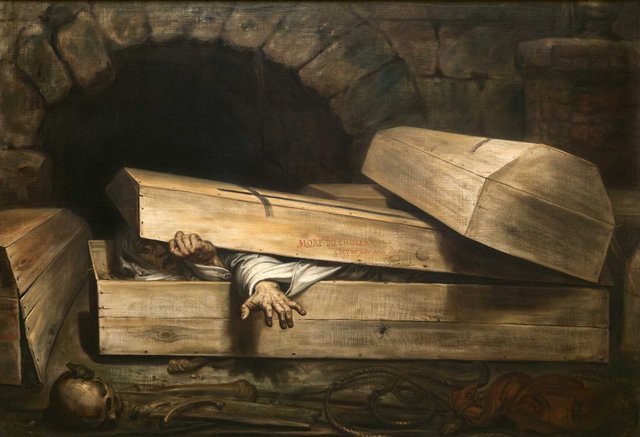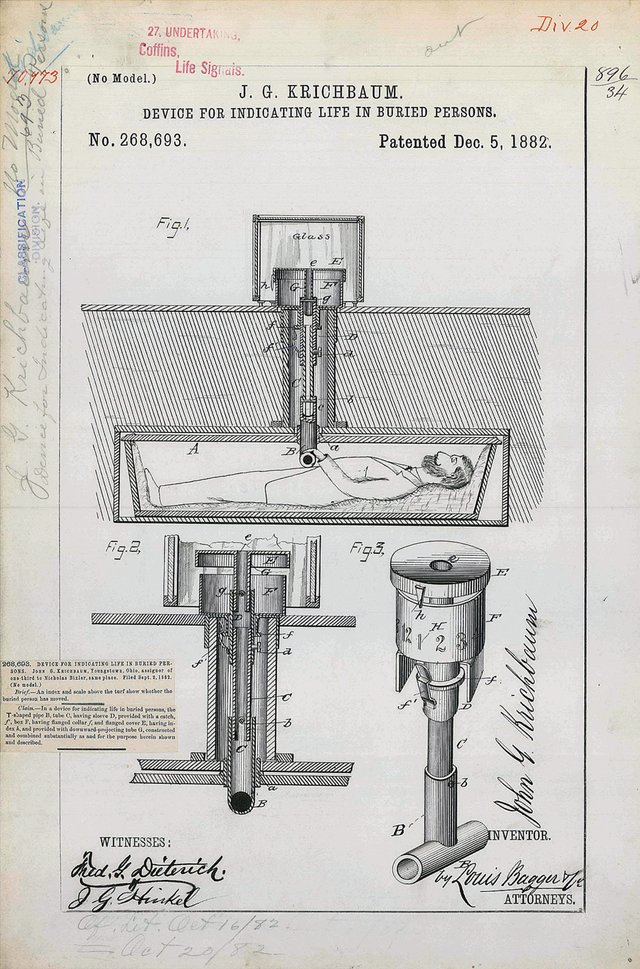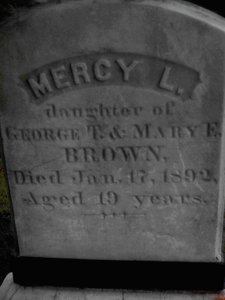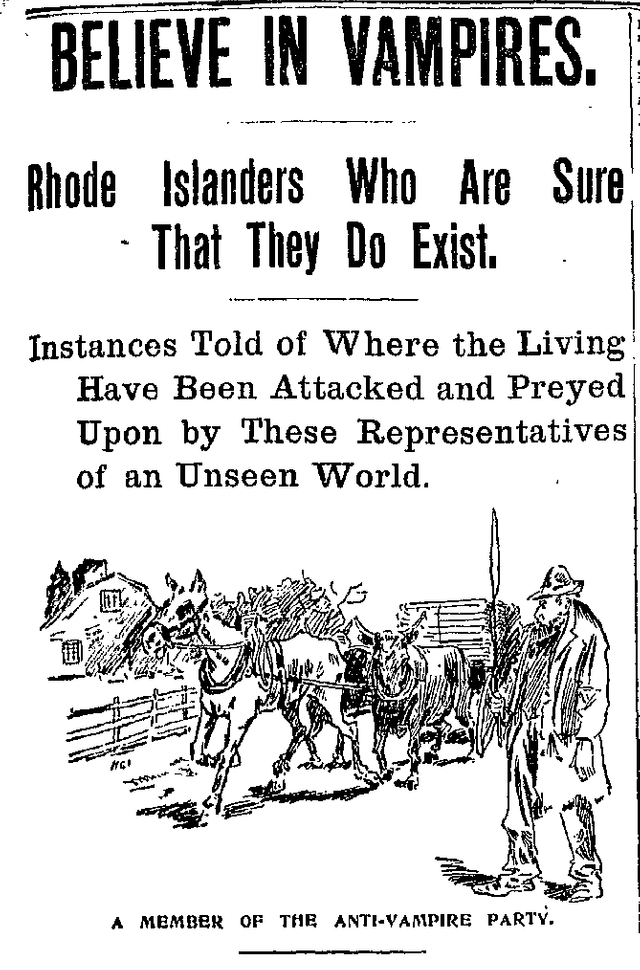ADSactly Health - When Dead is Not "Really Dead" (Between Medicine and Superstition)

Being buried alive and not being truly “dead”: between science, legend and mystery. "The Premature Burial" by Antoine Joseph Wiertz, 1854.
The Difference Between "Dead" and "Really Dead"
In the nineteenth century, Sarah Hart welcomed her 12-year-old niece Mary, who had recently been orphaned, to her home in New Haven, Connecticut. Mary's parents had died at sea and Sarah and Mary found solace in each other's company. With the passing years they became inseparable: it was as if they shared one mind and one heart. One morning, while the two women were working, Mary got sick. The reason wasn’t clear and initially Sarah thought that the niece had simply fainted. But it was not like that. Sarah held Mary in her arms as she exhaled her last breath: she was buried the next day. That night Sarah had a nightmare: she dreamed of her niece asking for help while she was trapped inside the coffin. The aunt believed it was more than a dream and that Mary was still alive, so she pleaded with the church officials to unearth Mary. The sad task turned to horror as soon as they saw Mary's lifeless body: her nails were broken and bloodied and the coffin's lining was tattered. On her face, the terrible portrait of death. All this really happened to Mary Hart on October 15, 1872. From this event, the legend of "Midnight Mary" and her ghost was born.
One thing we should be grateful for is that we live in a time when we can say with certainty that what is dead is "really dead".
Modern medicine has redefined the line between life and death. We have control over that thin line in a way that the older generations would have considered miraculous or the Devil's work: doctors regularly stop the heart during open-heart surgeries and then revive the patient with an electric shock. People whose brains have almost stopped working can be kept alive, we can remove an organ from a person and transplant it into another's body: it is no longer just a fantasy worthy of Frankenstein. This has always been the purpose of medicine, finding ways to eliminate pain and keep death at bay, although some of the most ancient methods may seem barbaric today.
No matter the era, the question has always been: "how far would we be willing to go to keep one of our loved ones alive?"
Therapeutic Exhumation
That of exhuming the dead to see if they were somehow alive, was a ritual that had a specific name: "therapeutic exhumation". This ritual was introduced in the eighteenth century by the philosopher and physician George Stahl, one of Germany's most respected physicians of the time. Stahl was obsessed with trying to understand what separated life from death, he believed that an invisible life force flowed through the human body and that this force made the lungs to breathe, the heart to beat and kept the blood flowing. He called this force "animus", soul. Decomposition could begin only once the soul had left the body: only in recent times we know that Stahl was wrong. However, in those days people believed that this theory was cutting edge science and used it to justify their superstitions about souls trapped in the bodies: to survive, these souls had to feed on the living, spreading diseases while feasting with their blood. This strange combination of inexact science and folklore was introduced in America by German army surgeons who helped the British during the American Revolution. Every time a city fell prey to tuberculosis, the corpses were exhumed: if they discovered parts of the body that weren’t sufficiently decomposed or uncoagulated blood, it could mean only one thing, that the soul was still trapped in the body. The heart was then surgically removed and cremated, so that the soul could find eternal rest once and for all.
Safely buried
In the late nineteenth century, declaring death was more a matter of guessing than true science. The fear of premature burial had a name: Tafophobia. Hence the origin of mortuary rooms, places where dead people - but perhaps not for real - could be "controlled", until the only unequivocal sign of death appeared: putrefaction, whose odor was covered with enormous floral arrangements that also served as an ornament for the most expensive structures. More and more techniques were also spreading that could provide a quicker verdict on the state of death, like poking with a pin under the nail, putting a live scarab inside the ear, playing a fanfare with the horn at a very short distance, cutting the sole of a foot with a razor, squeeze the nipples with specially designed forceps, insert a pencil into the nose. Dr. J.V. Laborde also invented a machine that pulled the tongue with a handle, based on the principle that we need to stimulate the most sensitive parts of our body to reanimate the "presumed" dead. For those who could afford it there was another option: the security coffin, like the one created by Thomas Pursell in 1930. Enterprising inventors, adhering to the spirit of the era, proposed several patents for this emerging class of mortuary products. One of the most famous projects was a long tube that provided fresh air and light. A doctor even invented a system that involved the use of a bell: they attached ropes to the hands, feet, and head of the corpse and if the bell rang the attendant had to call the gravediggers, who would have worked to dig up the coffin and free the occupier from a terrible situation. From here, the expression "saved by the bell".
The case of Mercy Brown from Rhode Island
How far can one man go to save the life of a loved one?
George Brown was a farmer who in the last twenty years of the nineteenth century was struck by tragedy: his whole family was killed by the tuberculosis epidemic, which in that period claimed the lives of one in four people in New England.
💊 Tuberculosis
Tuberculosis (or TB) is a disease caused by an infection from strains of mycobacterium, the most common being Mycobacterium Tuberculosis or Bacillus Koch. The infection mainly affects the lungs, but it can also develop in extrapulmonary sites such as in the pleura or bones, and hit the nervous or the urinary system. It spreads through air, from the coughing, spitting and sneezing of infected subjects presenting the disease in its active form. In fact, tuberculosis runs asymptomatic in 90% of cases (latent or chronic form) and occurs in active form only in 10% of patients. Although Koch's bacillus had been discovered in 1882, only in 1946, with the discovery of the antibiotic "streptomycin", a first cure for this disease became available. Tuberculosis has devastating effects on the patient: the eyes become red and swollen, the face becomes pale, and blood is coughed up. The association between tuberculosis patients and creatures of evil, such as vampires, derived precisely from their appearance: it became popular belief that patients (thought to be possessed by a demon) fed on the blood of their loved ones to reintegrate what was lost through coughing.
According to census records, Brown owned a small farm in the rural community of Exeter, Rhode Island. He had a proud family, made up of great workers who persevered in the face of adversity: his wife Mary Elizabeth and her three children Mary Olive, Edwin, and Mercy. His wife had contracted TB and died in agony; the same illness would claimed the life of their eldest daughter Mary Olive shortly thereafter. Although George was not a religious man, he prayed every night that this terrible evil would spare his children: for nine years George's prayers were answered and his family was spared.
Tuberculosis then returned and struck Edwin: to avoid losing his son, George spent part of his estate to send him and his daughter-in-law to Colorado Springs, where there was a special hospital for this disease. Three months after Edwin's departure, the illness knocked again at Brown’s door and this time it was Mercy's turn, the only family member left with his father.
After several weeks in Colorado Springs, Edwin's health improved: the therapies and the fresh mountain air had invigorated his lungs. But when Edwin came home, Mercy was already dead. The father’s joy in seeing his son healthy once more was short-lived: Edwin, now the only survivor of George’s three sons, became ill again.
This time, George Brown did not want to surrender to the impotence of medicine against the disease, not with his last loved one left alive. He allowed himself to be persuaded to perform an act of utter brutality, dictated by despair.
At that time, there was a superstition that a demon might possess the heart of a deceased and feed on the blood of his family members at night, one at a time, until they died. To demonstrate the presence of this demon, it was necessary to exhume the corpse and check that despite the passing of time it had not decomposed and that the heart still possessed live blood. If these conditions occurred, the heart of the deceased had to be burned to destroy the demon.
Thanks to the industrial revolution, the way people thought and how they imagined their future was changing. Science was producing miracles on a scale never seen before, yet medicine could not keep such pace, with doctors often groping in the dark when it came to establishing the cause of the diseases that affected many people. Among them, the tuberculosis that had almost annihilated George Brown’s family. Even if the bacterium that caused the disease, M. tuberculosis, had been discovered ten years before the events of the Brown family, a cure was not yet available, which left much room for less scientific remedies, that took hold of people's practices and beliefs. Like the belief that a long dead heart could still exert some kind of terrible power by absorbing life from the living.
Thus began the macabre ritual, and one by one, the corpses of his wife and children were exhumed. The only body not to be disfigured by decomposition, despite the months gone by, was that of his daughter Mercy. Her body was in a perfect state of preservation, having been kept for the whole winter in a hut and then buried after the Spring thaw.
The cold had slowed down the putrefaction process, but the peasants who accompanied George didn’t know that. Reluctantly, George allowed Mercy's heart to be extracted from the body and burned. A tonic was prepared with the ashes, which Edwin drank. The family expected the impossible to happen, but two months later Edwin Brown died of the disease at only 24 years of age. The local newspapers condemned and made fun of the Brown family and the inhabitants of Exeter for that nefarious act, accusing them of believing that a demon could live drinking the blood of the living at night while he was buried in his coffin. Some newspapers began to give a name to this demon, ”Vampire". The exhumation of the three bodies and the legend of Mercy, the first Vampire demon, quickly spread to all the newspapers of the new world. A cutout was found among the documents of a well-known writer, Bram Stoker, who was inspired by this story to write one of the most famous novels in the world: Dracula.
Authored by @cryptoitaly
Click on the coin to join our Discord Chat

Witness proposal is here:
Go To Steem Witness Page
In the bottom of the page type: adsactly-witness and press vote.

Use small letters and no "@" sign. Or, click here to vote directly!
Thank you!




Let me congratulate you on this job, @crytoitaly. It's really very interesting. You can tell that you handle the information and the story on this topic very well. Are you a doctor? Thank God, among the positive things that have advanced in the world are those that have to do with the medina. In one way or another, through literature and cinema, I had knowledge of the facts and techniques that you narrate here and may think it is fiction, but I am terrified to think it is true. The same happens with tuberculosis, which in a decade became a plague, a pandemic. Congratulations again to you and @adsactly for bringing texts like this. I really enjoyed reading it. Greetings
Yes I'm a medical doctor, a surgeon ! Thanks for reading this post!
It is good to find prepared people writing in steemit and on these rare topics. I keep reading to you. Greetings
Many superstitions emanate from the fear of spirits of the dead or different spirits. Certain events are attributed to those spirits who seek to point out to the living a danger, a misfortune or a happiness.
There is also a close link between superstitions and medicine. In most developing countries, modern medicine is very expensive and often inaccessible. That's why so many people turn to ancestral customs, spiritualism and superstitions to find remedies, or just as a precaution. What's more, they are more comfortable with a wizard who knows their customs and speaks their dialect than with a modern doctor. This is how superstitions subsist.
According to the traditions of superstition, illness and accidents are not mere fortuitous events, but the work of forces that live in the spirit world. Sorcerers may claim that an ancestor is upset, or mediums claim that a spell was cast on the victim through a rival wizard, which would explain the reason for the illness or accident.
Superstitions vary widely in different parts of the world, and their spread depends on folklore, legends, and local contexts. Nevertheless, all have one common denominator: the belief that one must appease someone or something from the invisible world of spirits.
Thanks for reading the article and many thanks for this precious comment. This sums up all the legends from middle age to nineteenth century
Thanks for the appreciation of my comment...
This post is the best i read in these days, i always been interested in macabre stuff, i did not know the story you told it must be used for a horror novel i bet exust a horror novel based on it. Tbc...it was hard to destroy this disease it worked for a lot of years, such a terrible thing.
Thanks darling! I don't know if there is an horror novel about brown tragedy but still there are many journal articles about it!
Wow too bad for the brown family, gone are the days of superstitious believe. Thanks alot to science, Science has taken over now and the use of science to produce drugs used for healing process is not something of the old. Should I say the brown family suffered from this superstitious believe. If I may ask, do vampires exist? Ain't that a superstitious believe?
There are lots of legends and myths about vampires,usually all these stories comes from strange behaviour of some people which had a disease or some psychiatric problem. So my answer is no but...who can say it?
Wow,this is amazing writing.
Your writing is very nice because your content to get knowledge.
I appreciate your writing for scientific history.
Thanks for reading! It was really nice to mix story, science and folklore during the writing!
Wow, it is impressive to read about everything exposed. Many times the reality overcomes the fiction and this is small at times. All those practices to verify if "the dead one is really dead" are chilling. I am glad that we have made a leap to all of this thanks to advances in medicine and other sciences. Unfortunately I have to say that tuberculosis that was a disease eradicated in my country has reappeared and now it is more complicated by the lack of medicines that plague us. He has made an excellent and interesting article, @crytoitaly. Thank you for sharing it through @adsactly.
To listen to the audio version of this article click on the play image.

Brought to you by @tts. If you find it useful please consider upvoting this reply.
Hmmm when "dead is not really dead" a horror tale, tragedy and all.
Excellent story telling
Had goosebumps reading this
This post was shared in the Curation Collective Discord community for curators, and upvoted and resteemed by the @c-squared community account after manual review.